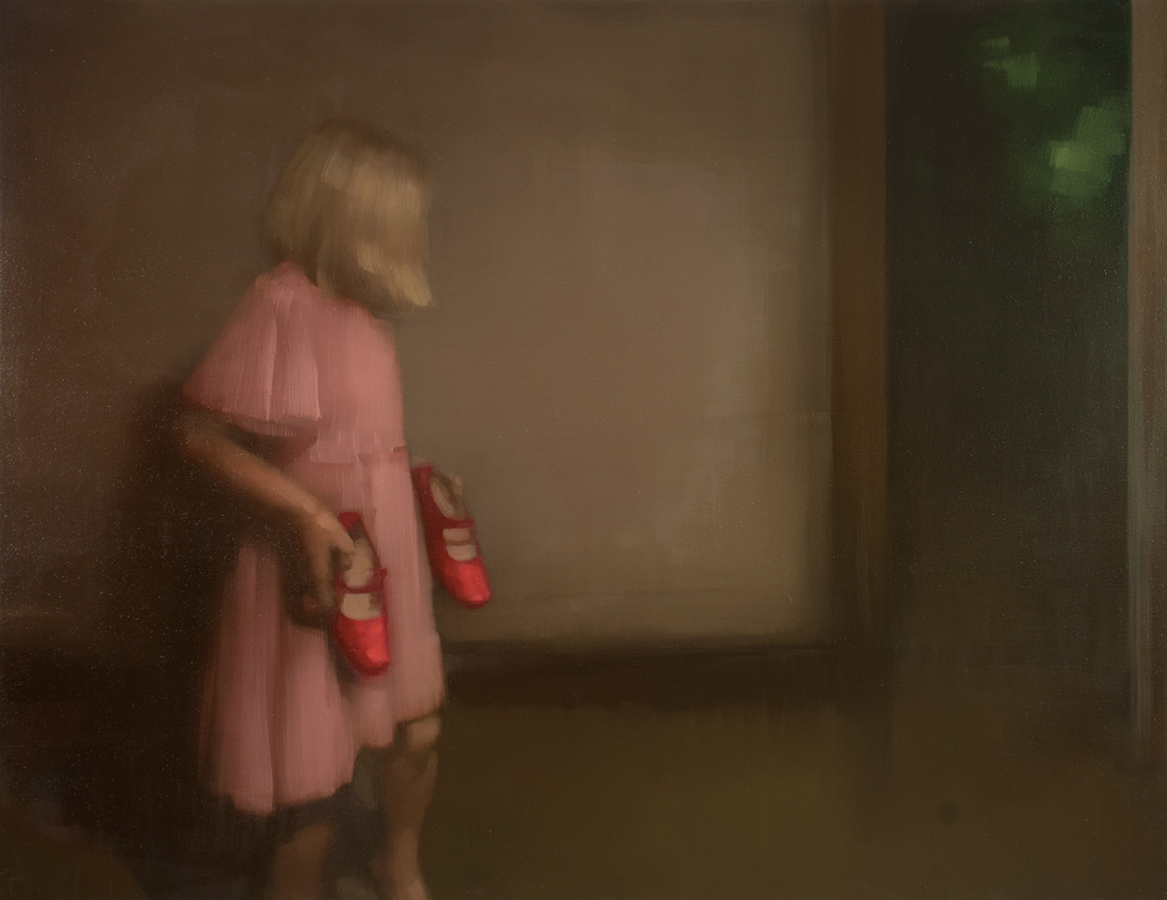Finnish artist Tiina Heiska´s work is based on photography, which she uses as a sketch or a draft for the later painted image. Her works carry a poetic mystique owing to the painterly quality but also to the fact that their inherent narrative is never obvious. Her work is intricately linked to cinematography, in particular to the film noir genre as well as to the style of directors such as Alfred Hitchcock and David Lynch, and Heiska makes use of this filmic language as a well-known subtext for her works. But where the traditional cinema relies on a continuous flow of events and thereby creates a story with a beginning and an ending, Heiska´s work is comprised of several series of stills, which form no obvious storyline, but rather leaves it to the viewer’s imagination to bridge the gap between image and story.
A female character, whose age is rarely discernible, and whose surroundings convey the peculiar sadness of impersonal hotel rooms, frequently inhabits Heiska´s paintings. This seductive and yet vulnerable looking creature often appears to be balancing on the edge between woman- and girlhood thus charging the images with a highly dangerous sexual quality.
Despite the tactile painterly surface of the images, the female appears removed from this world as if seen through a pane of glass or spied on through a keyhole. In spite of this, the viewer feels an eerie sense of taking part in the scenario, of being a character as well, albeit a character who has no power of the events that one senses have either already taken place or are just about to. These images contain a dual sense of longing and danger as they raise certain questions: Is the girl/woman alone or is she waiting for someone – a lover perhaps? – Is she only sleeping or has something far more sinister taken place, are we witnessing a crime scene or one just about to happen?
The film noir connotations are further heightened by the presence and style of shoes and clothing that also render the images almost ad-like in quality. This said it is however clear that the underlying narrative in Heiska´s paintings place them in a very different sphere from that of the advertisement. There is nothing on sale; what is offered is instead a view of a strangely engaging world or perhaps a screen onto which the viewer can project his or her desire.
Resembling film stills or out-of-focus snapshots, the paintings often convey a sense of movement, which is heightened by the fragmentary quality of the cutting as well as by the seemingly haphazard placing of the subject. This haphazardness is however only true as a first impression since a further study of the images shows that every element in the pictorial space is carefully arranged.
The grainy quality of the images can also be said to resemble that of a video surveillance camera leaving the viewer to adopt the suspicious role of the voyeur. This role is emphasized by the presence of a back turned woman – a well-known art historical motif that connotes absorption in ones own thoughts and as such a complete oblivion to being observed.
A woman in a black dress is lying on a bed, her blonde hair flowing towards the viewer. The dress is clearly not a nightgown and the room is impersonal and lit with a pale greenish light that emanates from a concealed source. She is propped up on her elbow and seems to have just woken from a dream. Perhaps she feels disorientated, uncertain of where she is. Many of Tiina Heiska´s paintings convey this angst-filled sense of confusion and disorientation often linked with waking up in unfamiliar surroundings.
The display of shoes, stockings and dresses convey an almost fetishist love of female accessories often associated with transvestism and indeed, since the subject wearing these accessories is generally only shown in part and is frequently faceless, the presumed gender of the subject can be said to rely on the viewer’s assumption.
Thus the element of desire is played out in many different categories and depends on the viewer’s own desire to shape the narrative. A woman lying on a bed, the fragmentary image of stockinged legs or red shiny shoes, and the close up of blond shoulder-length hair all demand some kind of story or explanation.
Perhaps more to the point than transvestism is, that Heiska is playing with identities by laying out the female accessories for her characters to wear or discard at will. The theme consequently becomes one of dressing up in order to assume a different identity: A girl going through her mother’s wardrobe wearing the high heels that connote a woman, or someone wearing a wig to go with a new dress or a different personality. The objects chosen by Heiska are by no means coincidental; they are the ones that carry the highest potential for transformation.
Tiina Heiska´s work revolves around the concept of identity focusing on perception, transformation and desire. The artist deals with the meaning of identity through questions into the realm of sexuality, age, and gender. What does it mean to be a woman or to be perceived as one, to what extent is identity either fixed or possible to transform, and what is the nature of desire? The artist provides no definite answers to these questions; instead she leaves them for the viewer to ponder.
The characters in Heiska´s work, her dramatis personae, always have a double existence, for although they seem to be caught in a snapshot, trapped in the briefest moment in time; they are also rendered eternal through the slow and lasting medium of painting. Heiska´s work thus expresses a longing for the moment, the instance, where everything can still happen, where possibilities are plenty, and where a crime can still be avoided or the waiting for the lover will end.
Maria Bregnbak, Art Historian, DK

